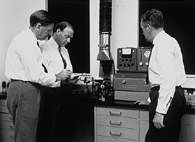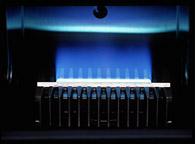
Atomic Absorption Spectrometer
1962
instrument for analysing metals in samples
When a metal is heated in a flame it emits specific frequencies of light - like a signature. Scientific instruments called spectrometers detect the presence of metals in samples by detecting these signatures.
Alan Walsh was a CSIRO scientist who improved on spectrometers.
He knew that metals that have been heated also absorb the same 'signature' frequencies of light that they emit. One day while gardening, he realised that, by shooting a measured beam of light at the correct frequency into a heated sample, he could measure the amount absorbed on the way through. So, instead of just detecting which metal was in a sample, he could get a precise measurement of how much.
Walsh built the first atomic absorption spectrometer (AAS) in 1954. The first ones were used to solve some important problems in medical treatment, agriculture and mining.
Several overseas companies bought licences from the CSIRO to make the instrument, as did one Australian company, Techtron. In the 1960s there was intense competition among the licensees to improve the design of the AAS to make it suitable for routine analyses. Techtron couldn't get the funds to go on upgrading its designs. Eventually the international firm Varian and Associates bought the company out, but continued production in Melbourne.
The AAS is one of the most important scientific instruments developed in this century. It's a crucial tool for chemical analysis today, and Varian Techtron continues to make and sell the instruments in many markets.
Walsh was recognised around the world, he was made a knight in 1977 and was honoured with medals and awards from 26 science and education institutions.
Who Did It?
Key Organisations
Varian Australia Pty Ltd : manufacture
CSIRO Division of Chemical Physics : research and development
Key People
Alan Walsh : researcher, inventor
John Willis : developed applications
Further Reading
'Walsh and the atomic absorption spectrometer'
John Willis
Australian Science Mag, 1987 (3).
Links
Information
from Victoria University, NZ
Related Innovations
Flame Ionisation Detector
|












